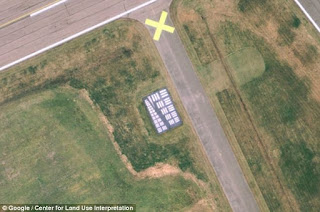 |
| Just think: a few years later chunks of that wall were being sold at K-Mart. |
 |
| Credit: the peculiar genius of Bill Watterson |
 |
| Just think: a few years later chunks of that wall were being sold at K-Mart. |
 |
| Credit: the peculiar genius of Bill Watterson |
 |
| The "bar code" at Walker Field, Maryland |
Consisting of a concrete pad measuring 78ft by 53ft and coated in a heavy black and white paint, they are decorated with patterns consisting of parallel and perpendicular bars in 15 or so different sizes.
This pattern, sometimes referred to as a 5:1 aspect Tri-bar Array, is similar to those used to determine the zoom resolution of microscopes, telescopes, cameras, and scanners.
The targets function like an optician's eye chart, with the smallest group of bars discernable marking the limit of the resolution for the camera being tested, according to the CLUI.
'For aerial photography, it provides a platform to test, calibrate, and focus aerial cameras traveling at different speeds and altitudes,' the CLUI adds.
'The targets can also be used in the same way by satellites.'Ironic, aye? That military secrets from fifty years ago are now wide-out in the open because of that same technology and Google Earth. Anyone with a desktop or tablet can now view what likely had been classified top secret by the CIA.
Sure, why not.
I first saw this movie in July of 1986 but it wasn't until I was in college a long time later that I found out the title. We were visiting family in Florida and playing a game of Monopoly in our motel room with my cousins and we thought we'd put some TV on. It was a PBS station showing... some very dark and gritty film about nuclear war in England.
I was 12 years old. I soon lost all interest in Monopoly and became transfixed to this film. The image of the young woman chewing through her newborn baby's umbilical cord is something that has haunted me to this day.
Threads originally aired on BBC Two in Great Britain in September of 1984. That wasn't very long after the network ABC aired The Day After here in America. If you've seen The Day After, well that's mild compared to Threads. And that's sayin' something. I was 9 when The Day After broadcast and it made darn near everybody watching (which was, well... darn near everybody) turn white with fright.
Threads, however, is a far more gruesome beast.
I'm posting this because Threads is a fascinating example of Cold War cinema. That was a very different time for those of us who grew up during it. We were the last of the children who came up scared about nuclear holocaust breaking out at any moment. And it could have happened...
Why didn't it? I've no doubt that history will remember that communism in Russia, could not sustain itself. Its people wanted to be free. An unsustainable economy failing to provide for a citizenry wanting better is a perfect combination for a government's collapse. We can see that in hindsight perfectly. But at that time...
Well anyway, here it is: from British television in 1984, a horrific yet intriguing relic of a world that nearly was: Threads.
It completely encircled what was then West Berlin.
It was one of the most tangible symbols of the Cold War.
It was declared by communists throughout the world that the wall would last forever.
I know of no better additional commentary that can possibly be made besides this picture of the chunk of the Berlin Wall that I have owned since 1993...

Something I came up with after the idea hit me on the drive back from Atlanta last week.
It could also be argued that Ronald Reagan won the Cold War without really firing a single shot, or inflicting any fatalities. He defeated the Soviet Union in the only way that it could be beaten: by forcing it to bankrupt itself to death.
Not even twenty years later, his legacy is becoming undone before our very eyes. And millions of people who have never had to know such things may soon be hearing quite a bit about bomb shelters and air raid sirens.
The deal was: Ballard would assist the U.S. Navy in examining the wreckage of two American nuclear submarines - the Thresher and the Scorpion - that were lost at sea in the Atlantic during the 1960s. At the time, there was concern that the Soviet Union might somehow find and exploit the sunken subs. The expedition was funded by the government and upon completion, Ballard would be free to continue his quest for the Titanic. All fine and dandy... except few people expected him to find the thing! Some in the Navy were alarmed that Ballard's discovery might arouse suspicion, but because of all the publicity about the Titanic itself nobody dared question the purpose of Ballard's mission.
Head over to the National Geographic website for more on the story.
